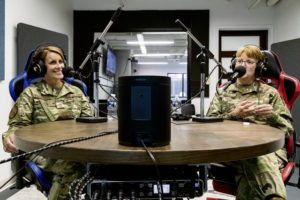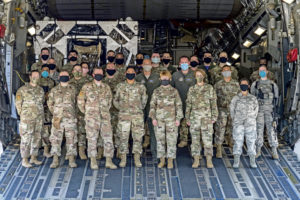DOVER AIR FORCE BASE, Del. — Lt. Gen. Dorothy Hogg, U.S. Air Force surgeon general, accompanied by Chief Master Sgt. Dawn Kolczynski, Air Force Surgeon General chief of medical operations, toured and learned about the Transport Isolation System aboard a C-17 Globemaster III, June 26.
While inside the TIS, Maj. Mark Dellinger, 36th Aeromedical Evacuation Squadron training flight commander, and Senior Master Sgt. Michael Malone, 36th AES training noncommissioned officer in charge and AE technician, both assigned to Keesler Air Force Base, Miss., briefed Hogg and Kolczynski on Dover AFB’s role in safely transporting patients, medical support personnel and aircrew during the COVID-19 pandemic.
On April 30, two Transportation Isolation Systems arrived at Dover AFB from Joint Base Charleston, South Carolina, as Dover AFB became the U.S. East Coast hub for TIS decontamination due to its strategic location and support facilities.

“The TIS mission started when Ebola (2014 outbreak) came about,” Hogg said. “We recognized that we would have a need to transport contaminated patients, and so we had to figure out pretty quickly how to do that on the back of the aircraft to keep the aircrew safe.”
By partnering with industries, the TIS was manufactured in approximately two weeks as a result of requirements identified during the 2014 Ebola outbreak.
“The capability that it has is that it contains the biological agent, chemical agent, whatever is inside, so that everybody else is clean and safe on the outside,” Hogg said.
Patient care is possible while being transported in a TIS aboard a C-17 or C-130 Hercules aircraft.
“We can deliver care inside there,” Hogg said. “We can do critical-care patients, we can do ambulatory patients and we can configure it in a way that is needed for the complexity of the patient.”
After exiting the TIS, the surgeon general and chief met with 10th Expeditionary Aeromedical Evacuation Flight aircrew, the TIS support team and 736th Aircraft Maintenance Squadron personnel before heading to Dover AFB’s Bedrock Innovation Lab to record a podcast on innovation and leadership.
During the podcast, Hogg spoke about the continuous process of innovation and the Negatively Pressurized Conex, or NPC, that was cleared for operational use on June 24 for C-5 Super Galaxy and C-17 aircraft.
“It actually was certified to fly this past week. It can hold more patients… instead of a small handful that the TIS can hold,” Hogg said.

The NPC can transport up to 28 passengers or 23 patients, either ambulatory or litter.
Speaking about the TIS mission, “It’s a Total Force mission … reservist, active duty and a variety of Air Force specialty codes (career fields) that are doing it, and it’s not their primary job,” Kolczynski said. “We’re putting them there, they’re learning and while they are doing the job here practicing, they are also being innovative and figuring out, ‘how do we do it better?’”
On the topic of innovation, the surgeon general expressed her perspective: “My platform is disruptive innovation. When I go out and talk to people, I challenge them to think without a box, not outside the box but without a box. We have to cultivate a culture where we are willing to take risks, where it’s okay no matter what rank you are, where you come from —that you can step up and say I have a better idea.”
The surgeon general also stressed the importance of communication and its challenges during COVID-19.
“It’s so difficult to try to keep everybody informed of what’s going on, and I’ve found that to be a little bit challenging, because you have a lot of players,” Hogg said. “So not only do you have Department of Defense in this fight against COVID, you also have Health and Human Services, Federal Emergency Management Agency and Centers for Disease Control and Prevention.”
During COVID, disseminating messages from multiple agencies at the right time to the right people is really important to the surgeon general.
“For us in the medical community, this was a medical contingency ops,” Hogg said. “We’ve never been in that kind of environment before; we’ve usually been in a supporting role. We are now in a supported role, and it’s been challenging for some line leaders to understand the medical community and how it operates.”


